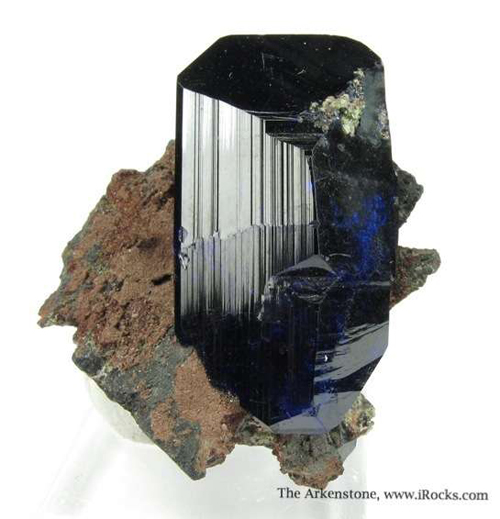The Mineral azurite

Azurite owes its name to its beautiful azure-blue color, which makes it a very popular and well-known mineral. Large, well-formed, and deep blue crystals from Tsumeb (Namibia), Bisbee (Arizona), and Milpillas (Mexico), make exquisite collector's minerals that are regarded as some of the finest mineral masterpieces in nature.
Azurite often occurs with green
Malachite, which may form green stains or specks on Azurite crystals or
aggregates. The two minerals sometimes occur admixed or
banded together, forming what is called "Azure-malachite" in the gem and mineral trades. A rarer Azurite mixture, known as "Bluebird", is Azurite mixed with dark red
Cuprite. Azurite, "Azure-malachite", and "Bluebird" all have gem uses.
In some localities, the Azurite undergoes a chemical change and loses some
hydroxyl,
altering the Azurite to
Malachite, but retaining the crystal shape of the original Azurite. Sometimes, only part of the Azurite is altered to Malachite, while the other part remains as Azurite. Such specimens are green on one end and blue on the other.
Linarite specimens are sometimes mistakenly sold as Azurite, since they both occur in the same locations and may strikingly resemble each other. However, simple tests on physical properties can accurately distinguish the two.
Chemical Formula
Cu3(CO3)2(OH)2
Color
Blue to very dark blue
Crystal System
Monoclinic
Properties
Streak
Light blue |
Hardness
3.5 - 4 |
Transparency
Opaque. Rarely translucent on thin edges. |
Specific Gravity
3.7 - 3.9 |
Luster
Vitreous or dull |
Cleavage
2,1 ; 3,2 |
Fracture
Conchoidal or splintery |
Tenacity
Brittle |
Other ID Marks
|
Crystal Habits
Usually in small crystals, which are in prismatic, tabular, or equidimensional form. Crystals are sometime striated. Other forms are massive, crusty, radiating, fibrous, earthy, columnar, stalactitic, as thin needles, and in ball-like aggregates. Also occurs in dense groups of tabular or prismatic crystals. Azurite may also form as a pseudomorph over other minerals, retaining the original crystal shape of the mineral that it formed a pseudomorph over.
Uses
Azurite is very popular mineral among collectors. Bright blue pieces are polished into cabochons and beads, and large masses are sometimes cut into ornamental objects. "Azure-malachite" is also carved as cabochons and beads.
Azurite was formerly crushed and used as a blue pigment.
Azurite is also an ore of copper.
Noteworthy Localities
Fine Azurite specimens have been obtained from numerous places. Some of the largest and best individual crystals have come from Tsumeb, Namibia. Morocco has also produced excellent crystals at Touissit and Kerrouchene. Good specimens have also come from Chessy, France; Laurium, Greece; the Black Forest, Germany; Cornwall, England; Burra Burra, South Australia and Broken Hill, New South Wales, Australia. An interesting occurrence of radial Azurite discs on a white Kaolinite matrix is the Malbunka Copper Mine, near Areyonga, Northern Territory, Australia.
In Mexico, Azurite occurs in the San Carlos Mine in Mazapil, Zacatecas; and in the relatively new Milpillas Mine in Cananea, Sonora, which has been providing outstanding crystals to the market.
In the U.S., fine specimens have come from numerous localities in Arizona, which include the famous locality of Bisbee, Cochise Co. Other Arizona localities include Ajo and Tiger, Pinal Co.; and Clifton and Morenci, Greenlee Co. Azurite also occurs in the Rose Mine in Grant Co., New Mexico, and elongated, tabular crystal clusters as well as rounded ball concretions have come from the La Sal District and La Sal Mountains, San Juan Co. and Grand Co., Utah. Also in Utah is the Apex Mine, Jarvis Peak, Washington Co.
Distingushing Similar Minerals
Linarite - Softer, heavier, doesn't effervesce in hydrochloric acid.
Lirconite - Lighter and more greenish in color, softer .
Connelite - Different crystal habits, doesn't effervesce in hydrochloric acid.
Cyanotrichite - Lighter in color.
Cornetite - More greenish in color, doesn't effervesce in hydrochloric acid.
Lazurite and Lazulite - Harder (5 - 6), occur in different mineral environments, and don't effervesce in hydrochloric acid.